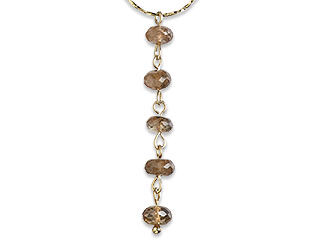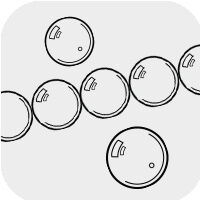Andalusite Meaning and Properties
Andalusite History
Andalusite was given its name by Jean-Claude Delamétherie in 1798 for Andalusia, Spain where it was first discovered. However, the original form of andalusite was first found before the birth of Christ in El Cardoso, which is a different Spanish region. Andalusite is also known as the "poor man's Alexandrite." One of the alternate names of andalusite is cross stone. The ancient Greeks used chiastolite, a form of andalusite with a distinctive cross pattern, for healing and decorative purposes.
Learn all about andalusite as our own graduate gemologist Dev shares insights into this stone. Discover how to make a pair of simple drop earrings for easy gifting or selling.

What are the Metaphysical Properties of Andalusite?
Among gemstone enthusiasts, andalusite meaning reflects the stone’s natural duality—its color-shifting nature is seen as a symbol of perspective and adaptability. Andalusite is thought to be the seeing stone that promotes the desire for self-realization, helping one to rebalance and re-align. This stone is said to help the wearer discover problems and emotional blockages, while pointing the wearer to the possible resolution. It is also considered a protection stone and is used to ward off the evil eye. The stone is believed to regulate sleep and help in alleviating the paralysis of nerves, muscles and joints. Wearing andalusite crystals is believed to help reduce fevers, the pain of arthritis, joint inflammation, gout and rheumatism. Andalusite is associated with the astrological sign of Virgo and vibrates to the number seven.
What Chakra is Andalusite?
Chakras are believed to be energy centers within the body that shape both physical vitality and spiritual clarity. Andalusite, with its earthy tones and intriguing color shifts, is traditionally associated with the solar plexus chakra—the seat of personal power, confidence and inner strength. Andalusite meaning is rooted in resilience and balance. It is said to align intention with action, helping to ground scattered energy and strengthen resolve. Wearing andalusite in an energy bracelet is a simple yet powerful way to keep this supportive energy close. These bracelets are not only easy to create, but also offer a beautiful and meaningful way to connect with your inner fire and steady purpose.
Solar Plexus Chakra (Manipura) - Yellow
- Location: navel (belly button)
- Represents: personal power; anxiety; forming opinions; fear; introversion; personal control
- Emotional issues: self-image; self-confidence; self-worth; expansiveness; transitions from simple emotions to complex ones
- Spiritual issues: growth; spiritual progress
- Physical issues: metabolism; digestion; energy; pancreatic troubles
- Gemstones: amber, andalusite , citrine, yellow calcite, tigereye
What is Andalusite Made From?
Andalusite is an aluminum silicate mineral that can be found in low-pressure metamorphic rocks where it crystalizes, forming prismatic crystals or massive columns. It is a polymorph or aluminum silicate, which consists of two other minerals: kyanite and sillimanite . The crystals of andalusite are often cut into gems when they show red or green hues, which resemble a form of radiance. This well-known ability to change colors is called pleochroism . Pleochroism is an optical phenomenon of exhibiting different colors when observed at different angles, especially with polarized light.
Andalusite is commonly found in Australia, Brazil, China, France, Russia, Spain, Sri Lanka, Sweden and the USA.
- Mineral Information: Aluminum nesosilicate
- Chemical Composition: Al2(SiO5)
- Color: Pink to red-brown, occasionally yellow, green, white, gray, rarely violet
- Hardness: 6-1/2 to 7-1/2 (Mohs)
- Specific Gravity: 3.13 – 3.21
- Refractive Index: 1.627 – 1.650
How Do You Clean Andalusite?
Although resistant to scratching, due to its hardness, andalusite is slightly brittle, so jewelry made from andalusite, such as rings, should be protected from sharp blows. Andalusite can be safely cleaned with lukewarm water and a mild soap. Wipe the surface with a soft cloth. Avoid chemicals such as household bleach. Use with ultrasonic cleaners is acceptable.
Andalusite FAQ
Q: Is andalusite a rare gemstone?
A: Andalusite is found in abundance all over the world, and is noted for its thermal stability, which makes it useful for various manufacturing processes. It is not rare.
Q: Does andalusite look different in different lighting conditions?
A: Andalusite is pleochroic, which means that the color will vary depending on the lighting and the angle from which it is viewed.
Q: Can I use andalusite in a bracelet?
A: With a Mohs hardness of 6-1/2 to 7-1/2, andalusite is durable enough for regular wear in a bracelet.
Q: How should I store jewelry with this gemstone?
A: Store andalusite jewelry in a soft cloth pouch or a lined jewelry box to protect it from scratches caused by contact with harder gemstones or metals.
Designing with Andalusite
Andalusite works great as an accent stone, especially in jewelry designs using clusters of brightly colored gemstones such as carnelian , lapis lazuli and peridot for a stunning effect. Andalusite is ideal as a center stone for unisex designs including pendants, rings, bracelets, necklaces, brooches, cuff links and tie tacs. Because of its shifting colors—pleochroism—it works best in jewelry designs that permit light to strike the andalusite components at different angles.
A Design Inspiration to Get You Started
Shop for Andalusite
**Please note that all metaphysical or healing properties listed are collected from various sources. This information is offered as a service and not meant to treat medical conditions. Fire Mountain Gems and Beads® does not guarantee the validity of any of these statements.
How did you like this resource? Your feedback helps us provide resources that matter to you most.
Copyright Permissions
All works of authorship (articles, videos, tutorials and other creative works) are from the Fire Mountain Gems and Beads® Collection, and permission to copy is granted for non-commercial educational purposes only. All other reproduction requires written permission. For more information, please email copyrightpermission@firemtn.com.


